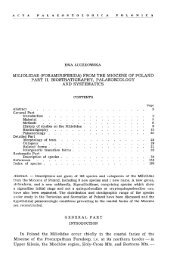Mass estimation in fossil sloths (Xenarthra, Folivora) from the Early ...
Mass estimation in fossil sloths (Xenarthra, Folivora) from the Early ...
Mass estimation in fossil sloths (Xenarthra, Folivora) from the Early ...
You also want an ePaper? Increase the reach of your titles
YUMPU automatically turns print PDFs into web optimized ePapers that Google loves.
INTRODUCTION<br />
The mostly fluvial deposits of <strong>the</strong> Santa Cruz Formation (late <strong>Early</strong> Miocene, ~18-16<br />
Ma) along <strong>the</strong> Atlantic coast of Santa Cruz Prov<strong>in</strong>ce (Patagonia, Argent<strong>in</strong>a) preserve a rich<br />
and diverse vertebrate fauna, compris<strong>in</strong>g xenarthrans such as <strong>sloths</strong> (<strong>Folivora</strong>), anteaters<br />
(Vermil<strong>in</strong>gua), and armadillos and glyptodonts (C<strong>in</strong>gulata), as well as marsupials,<br />
astrapo<strong>the</strong>res, notoungulates, litopterns, rodents, primates and birds (Tauber 1997a,b;<br />
Vizcaíno et al. 2012c). The rema<strong>in</strong>s are excellently preserved, thus offer<strong>in</strong>g <strong>the</strong> possibility of<br />
detailed paleobiological analyses.<br />
Eleven genera of relatively large <strong>sloths</strong> have been identified <strong>from</strong> <strong>the</strong> Santa Cruz<br />
Formation. These <strong>in</strong>clude Eucholoeops and Megalonycho<strong>the</strong>rium (form<strong>in</strong>g part of <strong>the</strong><br />
Megalonychidae, see Fig 1); Planops and Prepo<strong>the</strong>rium (Mega<strong>the</strong>riidae); Hapalops,<br />
Hyperleptus, Analcimorphus, Schismo<strong>the</strong>rium and Pelecyodon (stem mega<strong>the</strong>rioids sensu<br />
Gaud<strong>in</strong> 2004); and Nema<strong>the</strong>rium and Analci<strong>the</strong>rium (Mylodontidae). These <strong>fossil</strong> <strong>sloths</strong><br />
contrast <strong>in</strong> <strong>the</strong>ir diversity and size with <strong>the</strong> extant <strong>sloths</strong>, which are represented by only two<br />
genera (Bradypus and Choloepus), both fully arboreal and weigh<strong>in</strong>g less than 10 kg (Nowak<br />
1999). The Santacrucian genera are considered to represent <strong>the</strong> first major radiation of three<br />
of <strong>the</strong> five major folivoran families (Megalonychidae, Mega<strong>the</strong>riidae and Mylodontidae; see<br />
Fig. 1). By contrast, no representatives of Nothro<strong>the</strong>riidae are known <strong>from</strong> <strong>the</strong> Santa Cruz<br />
Formation, while Bradypodidae lacks any <strong>fossil</strong> record whatsoever (see Gaud<strong>in</strong> 2004,<br />
McDonald and De Iuliis 2008).<br />
Previous studies have analyzed <strong>the</strong> position of mammalian species with<strong>in</strong> <strong>the</strong>ir<br />
respective communities <strong>in</strong> terms of three ecological parameters: body mass, diet and substrate<br />
preference (<strong>in</strong>clud<strong>in</strong>g locomotion) (Andrews et al. 1979; Van Couver<strong>in</strong>g 1980; Reed 1998;<br />
Kay and Madden 1997; Vizcaíno et al. 2006, 2008, 2010, Kay et al. 2012). Out of <strong>the</strong> latter,<br />
2<br />
2
















